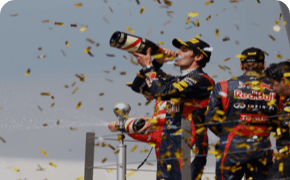Kevin Magnussen (DEN) McLaren and Daniil Kyvat (RUS) Scuderia Toro Rosso in parc ferme. Formula One World Championship, Rd1, Australian Grand Prix, Qualifying, Albert Park, Melbourne, Australia, Saturday, 15 March 2014
All the drivers making it off the grid safely
There were murmurs ahead of this race that one or two teams might have trouble getting off the start line smoothly, such are the differences between this year’s turbocharged power units and last year’s V8s. If there are any particularly slow starts the chances of a start-line or first-corner incident will increase dramatically.
The rookies holding their nerve
Who would have thought before this weekend that two of F1 racing’s three rookies would qualify in the top ten? McLaren’s Kevin Magnussen (P4 on the grid) and Toro Rosso’s Daniil Kvyat (P8) have already exceeded expectations, but coming through the race in such excellent positions will be considerably harder. Surviving what is likely to be a frenetic opening sequence of laps will be the first task, then they’ll have to manage their tyres, fuel load and pit stops under racing conditions for the first time. There’s distinctly less pressure on Caterham’s Marcus Ericsson who starts his maiden Grand Prix from 19th, but all three drivers will be determined to prove they belong on the grid. And if everything goes to plan, a podium finish isn’t out of the question for Magnussen.
Vettel trying to make up lost ground
To see Sebastian Vettel fail to make Q3 - for the first time since Belgium 2012 no less - was a real shock, especially as new team mate Daniel Ricciardo put in such a stellar challenge for pole. Red Bull say that the world champion’s engine software left him down on power, but whether he’ll be similarly afflicted in the race is unclear. Either way, Vettel is unaccustomed to starting so far back and can therefore be expected to aggressively attempt to move up the order, especially in the opening laps when his speed is proven.
Cars dropping out with reliability issues
Unsurprisingly, several teams have been hit hard by reliability woes this weekend, none more so than Lotus. The Enstone team have barely been able to get going at all and on the evidence we’ve seen so far it looks extremely unlikely that they’ll last the distance. Reigning champions Red Bull, meanwhile, have shown dramatic improvements over short runs, but are unproven over a race distance. Even this winter’s most reliable teams, such as Mercedes and Williams, cannot be sure of finishing the race and that should give hope to those runners who have qualified further back on the grid. Few would go as far as to say that making the chequered flag will guarantee a points finish, but it might not be too far wide of the mark.
Rear tyre wear
All of the drivers have waxed lyrical about the increased levels of torque produced by the 2014 power units, and that means that rear tyre wear will almost certainly be a limiting factor if the race is dry. Having said that, many of the drivers have had problems getting their front tyres to last too. The verdict? Those drivers with a propensity for looking after their rubber well are likely to benefit more than ever.
Carefully managing fuel loads
With the new restrictions on fuel (100kg per race), all of the teams worked hard on managing fuel consumption over winter, but in the heat of a race with positions at stake and tyres going off, it’ll be harder than ever to stick to a prescribed pace. It wouldn’t be surprising to see a large disparity between the pace of cars at certain points in the race as drivers switch between engine settings to save fuel.
Drivers struggling on the brakes
Albert Park has always been a circuit that asked a lot of the brakes, as it has several large braking events, but this year the as-yet unrefined fly-by-wire rear braking systems has made things doubly difficult for the drivers. Over the course of the weekend we’ve seen many arriving at corners seemingly unsure of how their car will behave under braking, and that’s brought about many lock-ups and plenty of trips into the gravel. It would not be surprising to see more of the same in the race, when the brakes will be put under their most intensive workout yet.
















